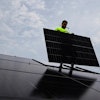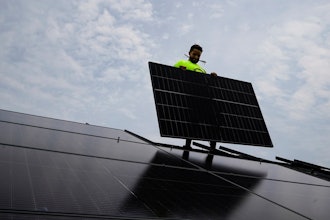Dubai has so many sunny days—more than 300 on average every year—it seems like a no-brainer for the city to use some of those rays to power its many glittering skyscrapers, massive malls and luxurious hotels. But that hasn’t been the case. Until recently, it was still cheaper to generate a kilowatt from oil or natural gas here.
The sun is setting on those days, however. Fadi Nassif, the regional commercial sales leader for GE Power Conversion in the United Arab Emirates, says that innovation, among other market dynamics, has made solar competitive with conventional power plants. “Utilities in sunny regions actually have a real choice if they want to use solar or fossil energy,” Nassif says. “Cost is no longer a differentiator.”
He should know. His business is helping the Dubai Electricity and Water Authority (DEWA) build a massive solar power plant in the desert on southern the edge of the city. The plant, called the Mohammed bin Rashid Al Maktoum Solar Park, is a three-stage project. When it’s completed in 2030, it will be the largest such installation in the region, generating up to 5,000 megawatts for people in the UAE.
The second stage of the project, which uses GE technology, will be able to generate up to 200 megawatts of electricity. That should be enough to power more than 30,000 homes and offset 250,000 tons of carbon dioxide every year, according to the website cleantechies.com.
In 2014, a consortium led by the Saudi Arabian developer ACWA made news when it bid to supply solar power from the second stage for less than $6 cents, then the unsubsidized world record low. The price has since fallen below $3 cents for the next stage of the project. That’s reportedly less than what it costs to generate power from fossil fuels in the region.
ACWA is leading the construction of the second stage as an independent power producer that sells the electricity to DEWA. “With this record low power delivery contract we wanted to open doors for a broader use of solar power,” says Thamer Al Sharhan, Managing Director of ACWA Power. “We live in a region that has an excellent record of irradiation, and with these track record tariff prices, the whole region will benefit and expand its solar energy footprint.”
GE is supplying the solar farm with a critical piece of technology called the inverter. Inverters convert the direct-current electricity produced by the solar panels into alternating current that can be used in homes and businesses.
One reason solar power has been relatively expensive—even though the fuel is free—is that some of it gets lost in the DC/AC conversions. The GE inverter, called LV5, can do the job extremely efficiently. It’s also liquid-cooled and hardened to withstand the searing desert temperatures and blowing sand.
Vlatko Vlatkovic, chief engineering officer at GE Power Conversion, told GE Reports that the LV5 could replace four inverters with one and save an estimated $6 million in capital expenditures for a 200-megawatt farm. “The new design allows us to send much more power through the same amount of copper and get big economies of scale,” Vlatkovic said. “You won’t need as many fans, filters, concrete pads and other components for the farm infrastructure. You can change the farm’s architecture.”
Nassif says there are a number of further solar projects planned for the region in Egypt, Jordan and Morocco. “We are excited to be part of the region’s solar growth and committed to supporting the energy diversification plans of the local governments,” he said.
Innovation does not stop here. GE engineers are already working on the next generation of the inverter using power electronics from a sturdy material called silicon carbide (SiC), which is also used inside locomotives, jet engines and gas turbines.
The SiC inverters – one of them is already working in Germany – will be able to handle even higher voltages, convert power even more efficiently and bring the price down further for future projects.






















